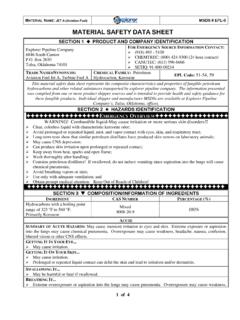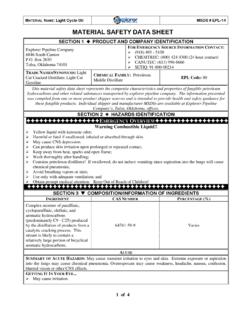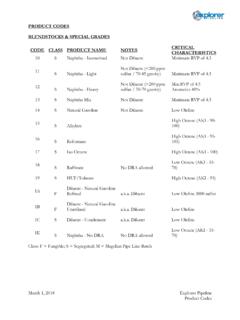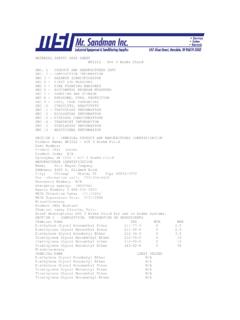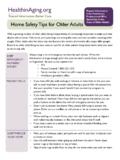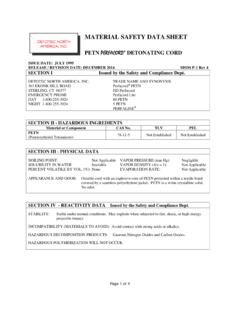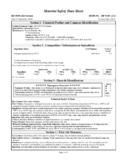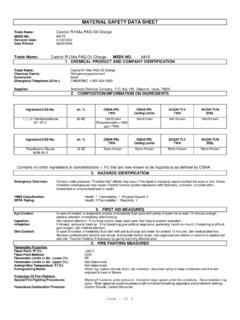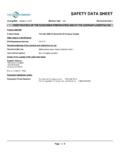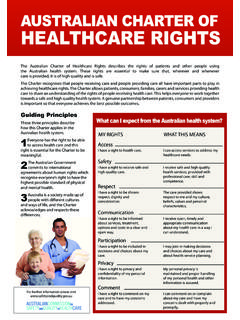Transcription of MATERIAL SAFETY DATA SHEET - Expl
1 MATERIAL NAME: MTBE MSDS # EPL-9 1 of 5 MATERIAL SAFETY data SHEET SECTION 1 X PRODUCT AND COMPANY IDENTIFICATION Explorer Pipeline Company 6846 South Canton Box 2650 Tulsa, Oklahoma 74101 FOR EMERGENCY SOURCE information CONTACT: (918) 493 - 5100 CHEMTREC: (800) 424-9300 (24 hour contact) CANUTEC: (613) 996-6666 SETIQ: 91-800-00214 TRADE NAMES/SYNONYMS: Methyl Tertiary Butyl Ether, Methyl Ether, Butyl Ether, or MTBE CHEMICAL FAMILY: Alkyl Ethyl EPL Code: 17 This MATERIAL SAFETY data SHEET represents the composite characteristics and properties of fungible petroleum hydrocarbons and other related substances transported by explorer pipeline company.
2 The information presented was compiled from one or more product shipper sources and is intended to provide health and SAFETY guidance for these fungible products. Individual shipper and manufacturer MSDSs are available at Explorer Pipeline Company s, Tulsa, Oklahoma, offices. SECTION 2 ; HAZARDS IDENTIFICATION )))))))))))))))))EMERGENCY OVERVIEW)))))))))))))))))DANGER! EXTREMELY FLAMMABLE LIQUID Clear, colorless liquid with ether-like odor; Eye and mucous membrane irritant - effects central Nervous system - harmful or fatal if swallowed - aspiration hazard; High fire hazard.
3 Keep away from heat, spark, open flame, and other ignition sources; Contact may cause eye, skin and mucous membrane irritation. Avoid prolonged breathing of vapors or mists; Inhalation may cause irritation, anesthetic effects (dizziness, nausea, headache, intoxication), and respiratory system effects; If ingested, do NOT induce vomiting, as this may cause chemical pneumonia (fluid in the lungs); and Obtain prompt medical attention. Keep Out of Reach of Children! )))))))))))))))))))))))))))))))))))))))) )))))) SECTION 3 W COMPOSITION/ information OF INGREDIENTS INGREDIENT CAS NUMBER PERCENTAGE (%) Methyl Tertiary Butyl Ether 1634-04-4 97+% ACUTE GETTING IT IN YOUR May cause minor eye irritation.
4 GETTING IT ON YOUR No significant signs or symptoms indicative of any health hazard are expected to occur as a result of skin absorption exposure. May produce skin irritation. SWALLOWING The major health threat of ingestion occurs from the danger of aspiration (breathing) of liquid drops into the lungs, particularly from vomiting. Aspiration may result in chemical pneumonia (fluid in the lungs), severe lung damage, respiratory failure and even death. BREATHING Excessive exposure may cause irritation to the nose, throat, lungs and respiratory tract. Central nervous system (brain) effects may include headache, dizziness, loss of balance and coordination, unconsciousness, coma, respiratory failure, and death.
5 MATERIAL NAME: MTBE MSDS # EPL-9 2 of 5 CHRONIC Medical information regarding special health effects is not conclusive. CANCER, REPRODUCTIVE AND GENETIC EFFECTS This product has produced cancer, developmental and systemic toxicity in laboratory animals following repeated exposure. The significance of these results to human exposures has not been determined. See Toxicological information (Section 11) For More information SECTION 4 FIRST AID MEASURES EYES: In case of eye contact, immediately rinse with clean water for 20-30 minutes. Retract eyelids often.
6 Obtain emergency medical attention if pain, blinking, tears or redness persist. SKIN: Immediately remove contaminated clothing. Wash skin thoroughly with mild soap/water. Flush with lukewarm water for 15 minutes. If sticky, use waterless cleaner first. INGESTION: If large quantity swallowed, give lukewarm water (pint) if victim completely conscious/alert. Do not induce vomiting/risk of damage to lungs exceeds poisoning risk. Obtain emergency medical attention. INHALATION: If overcome by exposure, remove victim to fresh air immediately. Give oxygen or artificial respiration as needed.
7 Obtain emergency medical attention. Prompt action is essential. NOTE TO PHYSICIAN: TREAT SYMPTOMATICALLY AND SUPPORTIVELY SECTION 5 a FIRE FIGHTING MEASURES Releases flammable vapors below normal ambient temperatures. When mixed with air and exposed to ignition source, vapors can burn in open or explode if confined. Flammable vapors may be heavier than air. May travel long distances along ground before igniting/flashing back to vapor source. FLASH POINT:(Method Used) -30 F FLAMMABLE LIMITS: LEL: UEL: AUTOIGNITION TEMPERATURE: 797 F EXTINGUISHING MEDIA: Dry Chemical, CO2, Foam for Alcohols, Water spray, and fog to cool exposures HAZARDOUS REACTIONS/DECOMPOSITION: Combustion may produce carbon monoxide, carbon dioxide, and acrid fumes.
8 Incomplete combustion generates highly poisonous carbon monoxide and perhaps other toxic gases. SPECIAL INSTRUCTIONS: Do not enter fire area without proper protection. Decomposition products possible. Fight fires from safe distance/protected location. Heat may build pressure/rupture closed containers, spreading fire, increasing risk of burns/injuries. Water may be ineffective due to low flash point. Even if MATERIAL is water soluble, may not be practicable to extinguish fire by water dilution. Apply water spray/fog for cooling.
9 Notify authorities if liquid enters sewer/public waters. SECTION 6 ACCIDENTAL RELEASE MEASURES Flammable liquid. Release can cause fire/explosion. Liquids/vapors may ignite. Evacuate/limit access. Equip responders with proper protection. Kill all ignition sources. Stop release. Prevent flow to sewers/public waters. Notify fire/environmental authorities. Blanket with firefighting foam. Restrict water use for cleanup. Impound/recover large land spill. Soak up small spill with inert solids. Use suitable disposal containers. On water MATERIAL partially soluble/may float or sink.
10 Contain/minimize dispersion/collect. Disperse residue to reduce aquatic harm. SECTION 7 HANDLING AND STORAGE Prior to working with this product workers should be trained on its proper handling and storage Store in tightly closed/properly vented containers away from heat/sparks/open flame/strong oxidizers. Use only non-sparking tools. Store drums with bung in up position. Carefully vent internal pressure before removing closure. Containers must be grounded before transfer. Electrical equipment should conform to National Electric Code. Handle used containers with care; residue may be flammable/explosive, unless blanketed with inert gas.

